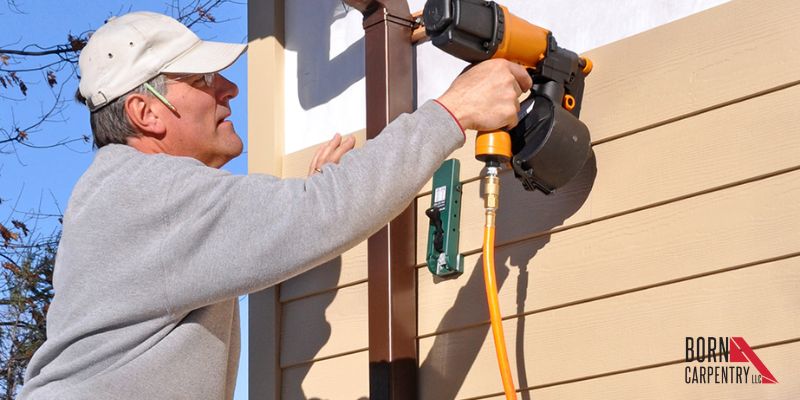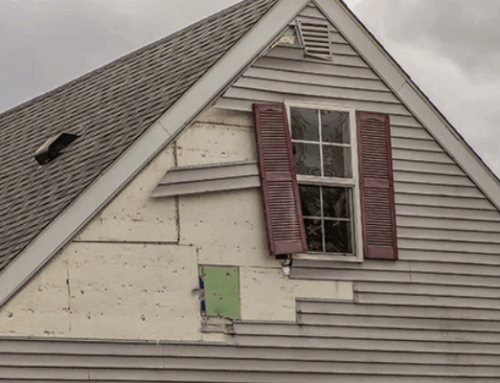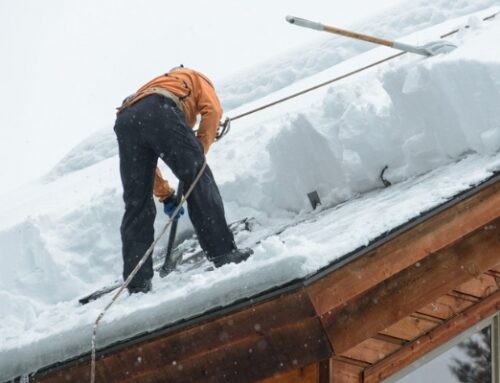Despite not being the most obvious home improvement project, siding replacement can be a wise investment for your house. The value of your home will increase, the curb appeal will increase and the energy efficiency will increase. Consider using the detailed guide below to navigate the siding replacement process and decide what is best for your home.
Why Replace Your Siding?

You might think about replacing your siding for several reasons.
The following are key indicators that it is time to replace the siding on your home…
#1 Warping

An underlying issue is frequently indicated by the presence of warped siding boards. Look at your house from different angles and look for places where the siding is not flat in comparison to surrounding panels. This will help you to determine the condition of your siding. This irregularity raises the possibility of serious damage beneath the surface, like rot.
For adequate inspection, you can gently probe the surface and the area beneath the siding with a screwdriver. A definite sign that it is time to replace the siding is when the substrate or siding material feels flimsy to the touch or cracks easily.
#2 Rotting
When examining wood siding, look for any brittle areas that are crumbling or are displaying signs that they may crumble. These areas frequently appear dull. This dullness indicates that moisture has begun to seep into the siding, which will lead to the degradation of the wood’s natural strength.
Lightly tap on the siding’s suspected dry rot areas to further evaluate the situation. Only the top layer of the siding will be unharmed in cases of dry rot, while the underlying layers will deteriorate. Finding these dry rotted areas is important because rot left untreated will spread, causing more decay and possibly jeopardizing the siding’s structural integrity.
#3 Cracking
Regardless of the type of siding used, noticeable cracks present serious risks because they leave gaps where moisture and pests can enter. If ignored, these cracks could compromise your siding’s barrier of protection, resulting in further problems and damage.
It is advised to consult a professional to accurately evaluate the cracks and decide the best course of action. An expert siding inspector can thoroughly assess the size and severity of the cracks, offering important information about the best solution. They can assess whether patchwork fixes can resolve the problem effectively.
#4 Holes From Insects And Birds
It can be difficult to find tiny holes in your siding caused by insects. However, some symptoms may point to a more serious problem. If you see a series of carved designs or see insects entering and exiting a small opening repeatedly, it might indicate the presence of a larger infestation or damage.
Additionally, keep an eye out for holes that birds have made in the siding, especially those that are higher up, as they may present particular difficulties and call for specialized care. Keeping an eye out for these signs will enable you to spot and take care of any potential insect or avian-related siding problems.
#5 Interior Moisture
It is crucial to look into the corresponding area on the exterior of your home if you notice moisture, mold or mildew inside. An indication of excessive moisture seeping in through damaged siding could be the growth of mold or mildew on interior walls next to exterior walls.
Additionally, moisture issues brought on by deteriorated exterior siding could also be indicated by peeling paint, sagging wallpaper and soft or crumbling plasterboard. In these circumstances, fixing the problem might necessitate updating the siding as well as the insulation in the house to avoid further moisture-related problems.
#6 Unexpected High Energy Bills
Your home may be experiencing air leakage if you notice a sudden rise in your utility bills. To find any potential leaks or draughts, start by inspecting the frames of your exterior doors and windows. Your siding is likely the main culprit if you discover that these areas are well-sealed.
When planning for a replacement, think about installing energy-efficient siding to effectively address this issue. With better insulation, less air leakage and less heat or cold transfer, your home’s siding can help you save on energy costs. By improving the indoor environment to be more effective and comfortable, this upgrade can ultimately contribute significantly to energy savings.
Types Of Sidings To Consider During Replacements
To fit your style and budget, there are many siding options available. The most common siding types are listed below…
- Vinyl siding: With many different colors and textures available in vinyl siding, it is one of the most affordable, low-maintenance options available.
- Fiber cement siding: This kind of siding is long-lasting, durable and resembles wood and stucco including color and texture.
- Wood siding: The timeless, conventional choice of wood siding can give your house an organic appearance. It does need more upkeep than other kinds of siding.
- Metal siding: The use of metal siding can add a sleek, modern appearance to your home that can add a touch of industrial or contemporary style.
There are many different siding options available for homes today. The benefits that various siding types can provide for your house can vary depending on things like:
- Durability and structure
- Maintenance
- Cost per square foot
- Return on investment
- Appearance
Maintaining Your Newly Replaced Siding
Prioritizing appropriate care and maintenance will ensure that your new siding lasts as long as possible and functions as intended. You can prevent potential damage to your home from siding failure by paying attention to its maintenance. Your siding needs to be thoroughly cleaned and inspected regularly to stay in top shape.
Do not forget that various siding types require various upkeep and cleaning techniques. For advice on how to maintain the siding on your home, refer to a professional on the cleaning and maintenance of siding.
Summary:
A siding replacement project is a major undertaking that can benefit your home in many ways. Your new siding will improve your home’s appearance, functionality and value for years to come with careful planning and execution.






